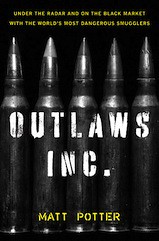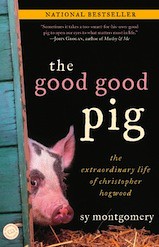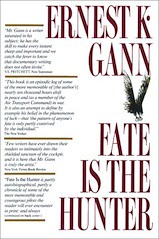“Now, as Ross runs up the engines, I remove the safety pin from the gear lever. I watch Ross anxiously. I am pathetically eager to perform my co-pilot’s duties quickly and efficiently. As he shoves the throttles forward and we start down the runway, I place my hand ready on the gear lever. I feel the tail lift. I bend down and slightly forward, my eyes fixed on Ross’s hand, waiting for the signal. I believe that we already have good speed, but I am watching his hand, not the indicator. His hand moves as if to leave the throttles. Take-off noise level in a DC-2 cockpit is terrific. I am certain Ross has called ‘Gear Up!’ I yank up the gear lever.” — Fate Is the Hunter, Ernest K. Gann
 The Water Thief
The Water Thief
by Nicholas Lamar Soutter
![]()
The author contacted me directly, asking me to read & review his self-published dystopian novel. I agreed.
After a strong opening chapter, I ran into a long segment where two characters debate the relative merits of corporate states and republics, and I thought “uh oh.” My fears were borne out, for this long dry conversation was the first of many. No, Soutter doesn’t tell the entire story through didactic dialog — there are brief interludes of action — but far too much of it reminds the reader of Ayn Rand.
The ideas behind the story are good ones, and you’ll quickly think of Margaret Atwood’s Oryx & Crake and The Year of the Flood, and to a degree Neal Stephenson’s Snow Crash: Soutter’s world is one where government has been replaced by corporate fiefdoms, complete with their own security forces, a world where those who are not safely employed (and oppressed) by the corporations are on their own, locked outside the corporate walls, eking out livings in the wastelands. But Soutter chooses not to tell the story by showing, but rather by telling, and that is this book’s weakness. If his ideas engage you — as they did me — you’ll plow on. But you’ll wish you were reading Atwood or Stephenson instead.
 A Clash of Kings
A Clash of Kings
by George R.R. Martin
![]()
Apparently this is number two of a series of novels. Who knew? Ha, ha, of course I knew. At this point, only two books in, I will merely quote my review of the first book, A Game of Thrones:
“I thought I’d outgrown this sort of thing. I’m happy to report I have not! This is … a grand, multi-generational adventure on the order of The Lord of the Rings. It is more adult than other aristocratic adventure stories, in that George R.R. Martin imbues his villains with realistic motives (mostly spite, greed, and a lust for power) and gives his characters sex lives. It is set in a fictional world somewhat resembling that of King Arthur, but it is a constrained world surrounded by unexplored areas full of menace. The menace is a constant presence, but doesn’t really manifest itself in this first volume, which is the story of an aristocratic northern family pulled into the court intrigues of an ineffectual king with a truly malign queen behind him. If there is anything about this book that puts me off, it is the abundance of knight-speak, but by golly the action never lets up and I kept turning pages to see what happened next. I haven’t been this wrapped up in an adventure story since, well, The Lord of the Rings! Great stuff! I have the second volume on my Nook now and can’t wait to read it.”
I will also quote what is probably the definitive GOT tweet, by @iscoff: “Game of Thrones reminds me of twitter a lot because there are 140 characters and terrible things are constantly happening.”
Book #2, like book #1, is a four-star read, fascinating and fun … even if you have already seen seasons #1 and #2 on HBO. Read them now. There’s so much more in the books!
 Escape from Camp 14:One Man’s Remarkable Odyssey from North Korea to Freedom in the West
Escape from Camp 14:One Man’s Remarkable Odyssey from North Korea to Freedom in the West
by Blaine Harden
![]()
A curiously flat and skimpy retelling of a North Korean prison camp escapee’s story. Something is missing here — I expected something more dramatic, more interesting. The escapee’s story is full of holes, because he shares only a heavily self-censored and sketchy outline of his tale with the American journalist who tells it. My reaction is suspicion — not of the journalist, but of the escapee and his tale.
What bothered me? For one, he says any other prisoner would have done what he did, ratting out his mother and brother to prison guards and then watching their execution. He says he felt nothing, that he did what he was trained to do. And yet he clearly knows what he did was shameful and wrong, because for months afterward he lied about it. For another, we’re told that no one — not one person, ever — had ever escaped from this particular prison camp. Yet members of his own imprisoned family almost casually, it seems, planned an escape, and his own escape and travel to China sounds strangely easy (he lingered in the village next to the camp for several days, and no one came looking for him? Give me a break). These parts of his story ring false.
One thing I have no doubt about is the horror of conditions inside North Korea, for prisoners and regular citizens alike. The place is an abomination. But if you are as fascinated by North Korea as I am, there are far more interesting and educational books to read, and I would recommend you start with Nothing to Envy: Ordinary Lives in North Korea by Barbara Demick; for a fictional but seemingly well-researched treatment of the prison camp experience, The Orphan Master’s Son by Adam Johnson.
 The Outlaws Inc.: Under the Radar and on the Black Market with the World’s Most Dangerous Smugglers
The Outlaws Inc.: Under the Radar and on the Black Market with the World’s Most Dangerous Smugglers
by Matt Potter
![]()
Matt Potter takes an intrinsically-interesting subject — the worldwide illicit air cargo/smuggling network that came into existence after the breakup of the Soviet Union, flown by fearless Russian crews manning high-time and often derelict Ilyushin and Antonov cargo planes, fronted by movers and shakers like the infamous Victor Bout — and writes a book that, after the first 50 to 60 pages, is all repetition. This would have been a terrific long article in a magazine like Rolling Stone or Esquire. Expanded to book length, it’s almost unreadable, at least if you have a functioning memory. Didn’t I just read that? Why yes, he mentioned it on page 10. And what’s this? It’s the story told on page 10 all over again, with extra words that add nothing. Very disappointing. If I were not a dyed-in-the-wool aviation buff I would give it one less star for trying to waste so much of my time.
 The Good Good Pig: The Extraordinary Life of Christopher Hogwood
The Good Good Pig: The Extraordinary Life of Christopher Hogwood
by Sy Montgomery
![]()
Another book club selection; unfortunately one I finished more out of courtesy than genuine interest. Sy Montgomery writes well, and she tries mightily hard to impart some larger meaning to her pet pig’s life, but in the end the pig is but a pig, and all Sy’s mooning over Buddhism, the earthy wisdom of aboriginal pig herders, and the healing powers of a vegan diet failed to persuade me that Christopher Hogwood was anything but a pig. Sy’s chickens, it seemed to me, had more personality, and the animal who stole the show was Tess, Sy’s border collie.
Actually, the parts of the book I most enjoyed were the autobiographical details of Montgomery’s life: her marriage, the regret I sensed over her choice to remain childless, her relationship with her truly horrible parents, the time Jane Goodall snubbed her, her “authentic” lifestyle (as opposed to the authentic-without-airquotes lifestyles of poor people), and, curiously, her long and detailed descriptions of the goodies that went into Christopher’s slop bucket. Donuts floating in pancake batter? Yum!
Was I entertained? Yes, but by peripheral details, not by the subject of the book itself. Did I learn anything? Not really. This is pretty light stuff; better living-with-animals books are available. Jon Katz has written a few nonfiction accounts of raising dogs and other animals on a farm; one I read with great pleasure was titled Izzy and Lenore: Two Dogs, an Unexpected Journey, and Me. Another excellent choice would be Steven Kottler’s A Small Furry Prayer: Dog Rescue and the Meaning of Life.
 Fate is the Hunter
Fate is the Hunter
by Ernest K. Gann
![]()
A fascinating memoir by an airline pilot who flew from the late 1930s into the 1950s, the era of DC-2s, DC-3s, and DC-4s. Gann shares some great stories, some of which will have you gripping the edges of the book like a control yoke, your knuckles white. My god, those were dangerous days, and the early airline pilots took risks that would be inconceivable today, letting down through solid weather with inaccurate altimeter settings until as low as fifty feet above the ground or ocean, trying to establish visual contact with the surface; flying into thunderstorms and icing conditions; pressing fuel minimums beyond the point of no return. Reading Gann’s litany of departed pioneers — men who died, one after another, usually a microsecond before their trusting passengers — is a bit like standing inside the cleft of the Vietnam War Memorial, thinking “my god, all those names!”
This is not merely a history of the airline industry’s early days, it is also a history of the US Army Air Corps’ transport command, set up in the early days of WWII; the establishment of trans-Atlantic routes and refueling stops; a history of American airline involvement in Central and South America; and a lengthy treatise on the airline seniority system.
As a memoir, it’s not totally accurate, but only because Gann changes the names of the departed and steadfastly refuses to name any of the airlines involved, including his own. It is typical of airline pilots never to slight their own organizations, I suppose, and Gann was no exception.
Why not four stars? Because this is a very wordy book, and I found myself skimming over some philosophical and repetitious paragraphs, trying to skip ahead to pick up the thread of a story. The book is essentially a sting of “there I was” tales, all fascinating — but sometimes Gann makes you wade through thigh-deep “there but for the grace of god” moralizing to get to the outcomes. Some of Gann’s musings are vital to the book, however, and you have to be careful not to skip over those. At the heart of this book is a dissertation on fate, the fickleness thereof. Why did Gann survive this thunderstorm when so-and-so, a vastly more experienced pilot, died under identical circumstances? Why did Gann’s engines keep running when, after he landed, ground crews found the tanks bone dry?
I’m an aviator, but my experience is in military fighters, not the airlines. Still, I’m fascinated by the story of aviation’s development in the US and the world, and this book is an insider’s take, told from the cockpit. Despite skimming over a few wordy paragraphs, I couldn’t put it down.